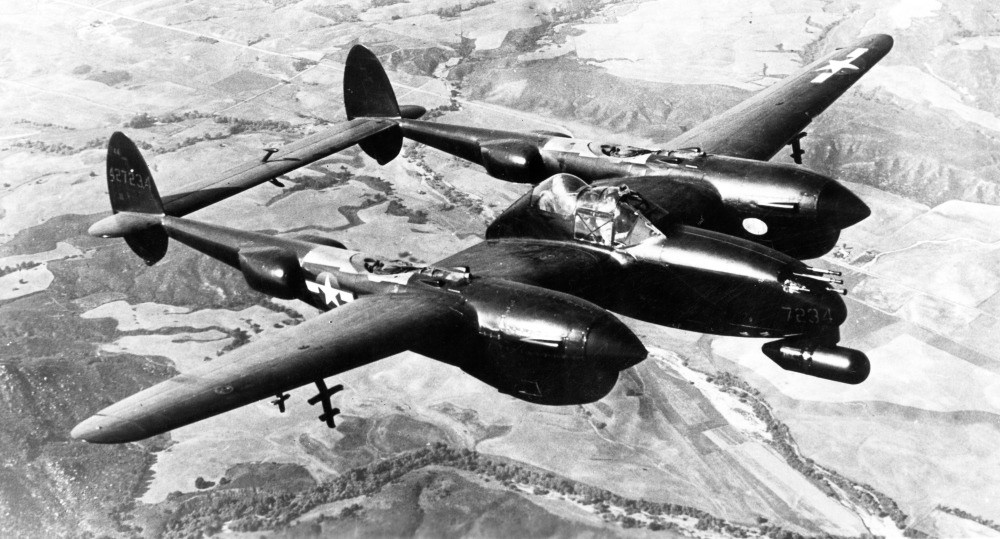JeffroK
Posts: 6391
Joined: 1/26/2005
Status: offline

|
From the archives of Joe Baugher:
http://www.joebaugher.com/usaf_fighters/p70.html
http://www.joebaugher.com/usaf_fighters/p38_16.html
Since the USAAF had no night fighter units when the USA entered World War 2, a night fighter training organization was established at Orlando, Florida. Most of the P-70 Nighthawk aircraft served there with the 481st Night Fighter Operational Training Group to develop tactics and procedures for radar-controlled night interceptions and to train the crews of nineteen night fighter squadrons. Very few of these P-70s ever went overseas, most remaining in the USA to be passed on to the next night fighter units that needed to be trained. Most units trained on the P-70 were reequipped with the Northrop P-61 Black Widow before they transferred overseas.
Only five night fighter squadrons were still equipped with P-70s at the time they were deployed overseas. Four P-70-trained night fighter squadrons were sent with their aircraft to North Africa in 1943 for service with the Twelfth Air Force. However, when they got there, these outfits used Bristol Beaufighter VIF fighters obtained from Britain under Reverse Lend-Lease. The 427th Night Figher Squadron took its P-70s with it when it deployed to Italy, but the squadron exchanged its P-70s for Northrop P-61 Black Widows before it became operational.
The P-70 actually saw some combat action in the Pacific Theatre, although their service there was quite brief. The 6th Night Fighter Squadron began operations in February of 1943 with its P-70s from Henderson Field, Guadalcanal, in an attempt to intercept high-flying Japanese night raiders. It was later supplanted by the 419th Night Fighter Squadron. The 418th and 421st Night Fighter Squadrons flew P-70s operationally in New Guinea for a brief time. The P-70 was not very successful in combat, scoring only two kills during the entire war. The P-70 lacked sufficient performance to intercept Japanese night raiders unless it was extremely fortunate. P-70s were replaced with P-61s just as soon as these aircraft would be made available.
Early in 1943, at least two unidentified P-38Fs were modified in the field by the Fifth Air Force as single-seat night fighters by fitting an SCR540 radar with yagi antennae on the nose on both sides of the central nacelle, and above and below the wings. In order to make room for the radar, two of the 0.50-inch machine guns and their ammunition boxes had to be moved forward. Three P-38Js were also modified in the field as experimental night fighters.
However, these modifications were all single seaters, and it was found that the flying of the plane and the operation of the radar was too much of a job for just one person. Consequently, Lockheed attempted to adapt the P-38L as a two-seat night fighter. In 1944, Lockheed converted P-83L-5-LO Ser No 44-25237 as a two-seat night fighter, with the radar operator sitting aft of the pilot under a raised section of the canopy. The aircraft was fitted with an AN/APS-6 radar in an external radome underneath the nose, relocated radio equipment and anti-flash gun muzzles.
This modification was successful, and provided the USAAF with a night fighter having a top speed of 406 mph at 15,000 feet as compared to only 369 mph at 20,000 feet for the Northrop P-61A Black Widow. Consequently, the Army issued a contract change calling for the Lockheed Modification Center in Dallas to convert 80 additional P-38L-5-LOs into P-38M twin-seat night fighters (some sources give 75, but 80 serials are identified). They were painted glossy black overall. These were just entering service when the war ended. The P-38M saw operational service in the Pacific in the last few days of the war. It was an effective night fighter with very little performance penalty over the standard single-seat Lightning.
Flash eliminators were fitted to all guns, mainly to aid the pilot in retaining night vision when they were fired. Experiments were conducted with the object of shielding the turbosupercharger exhaust, but the entire exhaust system was so hot that it glowed at night, making the small reduction of visibility possible with the shielding of the actual efflux relatively pointless. Consequently, no modifications of the exhaust system were undertaken on "production" P-38Ms. Initial climb rate was 3075 feet per minute, and an altitude of 20,000 feet could be attained in 8.7 minutes.
A total of 80 P-38Ls were converted to P-38M configuration. Serials of P-38Ls converted to P-38M configuration were as follows: 44-26831, 26863, 26865, 26892, 26951, 26997, 26999, 27000, 27108, 27233, 27234, 27236, 27237, 27238, 27245, 27249, 27250, 27251, 27252, 27254, 27256, 27257, 27258, 53011, 53012, 53013, 53014, 53015, 53016, 53017, 53019, 53020, 53022, 53023, 53025, 53029, 53030, 53031, 53032, 53034, 53035, 53042, 53050, 53052, 53056, 53062, 53063, 53066, 53067, 53068, 53069, 53073, 53074, 53076, 53077, 53079, 53080, 53082, 53083, 53084, 53085, 53086, 53087, 53088, 53089, 53090, 53092, 53093, 53094, 53095, 53096, 53097, 53098, 53100, 53101, 53106, 53107, 53109, 53110, 53112.
_____________________________
Interdum feror cupidine partium magnarum Europae vincendarum
|
 Printable Version
Printable Version











 New Messages
New Messages No New Messages
No New Messages Hot Topic w/ New Messages
Hot Topic w/ New Messages Hot Topic w/o New Messages
Hot Topic w/o New Messages Locked w/ New Messages
Locked w/ New Messages Locked w/o New Messages
Locked w/o New Messages Post New Thread
Post New Thread